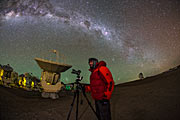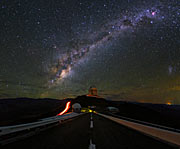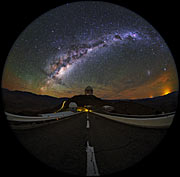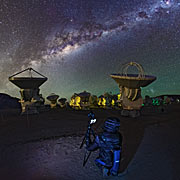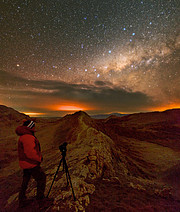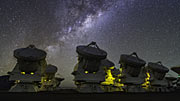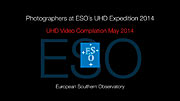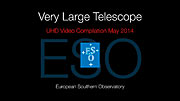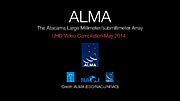Mitteilung
Erste Ergebnisse der Ultra HD-Expedition der ESO
9. Mai 2014
Zwar ist die Ultra HD-Expedition der ESO nun vorbei, es ist jedoch auch hinter den Kulissen viel zu erledigen, um all das Bildmaterial zusammenzufassen und aufzubereiten, das vom Team aufgenommen wurde – immerhin kam eine Staffelung von 10 TB an Bildern und Videos zusammen. Mit der vierfachen Auflösung im Vergleich zu HD, hebt Ultra HD unsern Blick auf den Nachthimmel in eine neue, immersive Dimension. Das Expeditions-Team kann nun erste Ergebnisse des spektakulären UltraHD-Bildmaterials präsentieren und uns so das Universum etwas näher bringen.
Während die Produktion von Displays und Kameras für Ultra HD-TV floriert, wurden bisher sehr wenige Inhalte in Ultra HD allgemein zur Verfügung gestellt. Die ESO ändert dies nun, indem sie Ultra HD-Inhalte kostenlos für alle, sowohl für Konsumenten als auch für die Verbreitung, in einem sehr liberalen Lizenzmodell anbietet.
Vor etwas über einem Monat sind der ESO-Videograf Herbert Zodet sowie die drei ESO-Fotobotschafter Yuri Beletsky, Christoph Malin und Babak Tafreshi zu ihrer Expedition nach Chile aufgebrochen. Ihr Ziel war die Aufnahme von Bildmaterial an den drei Beobachtungsstätten der ESO in all ihrer Pracht unter Verwendung der modernsten Ultra HD-Instrumente [1].
Zunächst hat das Team das Paranal-Observatorium der ESO im Norden Chiles besucht. Hier ist das Aushängeschild der ESO der europäischen bodengebundenen Astronomie angesiedelt, das Very Large Telescope (VLT). Anschließend brachen sie zu ALMA auf, dem Atacama Large Millimeter/submillimeter Array, einer riesigen, neuen Anlage 5000 Meter über dem Meeresspiegel auf dem Chajnantor-Plateau, die das kalte Universum untersucht. Zum Abschluss führte der Weg nach La Silla, dem ersten Observatorium der ESO, der Heimat des 3,6-Meter-Teleskops der ESO und des 3,58-Meter-New Technology Telescopes [2].
Das Team hat ein weites Spektrum an Inhalten abgedeckt. Es sind sowohl Zeitrafferaufnahmen, Standbilder als auch Panoramaaufnahmen in Ultra HD-Qualität entstanden. Zusätzlich wurde Bildmaterial von Zeitrafferaufnahmen und Standbildern im Ganzkuppelformat für Planetarien erstellt – diese Aufnahmen werden auch in der ESO Supernova ab 2017 verwendet werden. Die fast perfekten Atmosphäre-Bedingungen an jedem der Standorte ermöglichen einen kristallklaren Blick in den Nachthimmel, was die visuell beeindruckende Produktion noch weiter verbessert.
Ein Teil der eindrucksvollen Videos und Fotos wird nun veröffentlicht, einige sind in dieser Mitteilung in der rechten Seitenleiste verlinkt. Weitere Links zu ersten Ergebnissen der Expedition finden Sie hier:
-
Für Medien und andere:
- UHD-Standbilder, darunter einige große Panoramaaufnahmen, die sich in die bereits sehr große Sammlung von hochauflösenden Standbildern und Panorama-Standbildern der ESO einfügen
- UHD-Zeitraffer, die die bereits große Sammlung an Zeitrafferaufnahmen der ESO ergänzen
- UHD-Tageszeit-Videomaterial, das die bereits sehr große Sammlung der ESO an Ultra HD-Videos vergrößert
- Für Fernsehsendungen ist die Expedition in fünf UHD-Kompilierungen erhältlich, darunter:
-
Für Planetarien:
- UHD-Ganzkuppel-Standbilder (Fischauge, 4K) (ergänzend zur ESO-Sammlung an Ganzkuppel-Standbildern)
- UHD-Ganzkuppel-Zeitraffer (Fischauge, 4K) (ergänzend zur ESO-Sammlung an Ganzkuppel-Zeitrafferaufnahmen)
- UHD-360-Grad-Panoramaaufnahmen (ergänzend zur ESO-Sammlung an 360-Grad-Panoramaaufnahmen)
Viele weitere befinden sie in der Warteschlange, seien Sie also gespannt auf die nächsten Ultra HD-Inhalte in den kommenden Wochen. Die allerbesten Bilder werden als ESO-Bilder der Woche in den kommenden Monaten veröffentlicht. Schauen Sie außerdem auf den nächsten ESOcast über die Ultra HD-Expedition der ESO.
Endnoten
[1] Die Ausrüstung beinhaltete: Vixen Optics Polarie Star Tracker, Canon® EOS-1D C-Kamera, Stage One Dolly und eMotimo TB3 3-axis motion control camera robot, Angelbird SSD2go, LRTimelapse-Software. Peli™ Cases, 4K PC Arbeitsplätze von Magic Multimedia, Novoflex QuadroPod-System, Intecro-Batterien und Granite Bay Software.
[2] Der gesamte Reise-Zeitplan der Expedition kann hier abgerufen werden. Die persönlichen Berichte zu dem 17-tägigen Abenteuer finden Sie auf dem ESO-Ultra HD-Expeditions-Blog.
Weitere Informationen
Sie können der ESO-Ultra HD-Expedition auf Twitter unter @ESO und unter dem Hashtag #ESOultraHD folgen.
Die ESO-Ultra HD-Expedition wurde von den folgenden Technologiepartnern unterstützt: Canon, Kids of All Ages, Novoflex,Angelbird, Sharp, Vixen, eMotimo, Peli, Magic Multi Media, LRTimelapse, Intecro und Granite Bay Software. Informationen über die Technologiepartner der Expedition sind hier verfügbar.
Links
- ESO-Ultra HD-Blog
- Die ESO präsentiert: die ESO-Ultra HD-Expedition
- Lesen Sie mehr über die Expedition in der PDF-Broschüre (26,7 MB)
- Direkte Links zu den UHD-Produkten:
Kontaktinformationen
Richard Hook
ESO, La Silla, Paranal and E-ELT Press Officer
Garching bei München
Tel: +49 89 3200 6655
E-Mail: rhook@eso.org
Über die Mitteilung
| ID: | ann14035 |
Our use of Cookies
We use cookies that are essential for accessing our websites and using our services. We also use cookies to analyse, measure and improve our websites’ performance, to enable content sharing via social media and to display media content hosted on third-party platforms.
ESO Cookies Policy
The European Organisation for Astronomical Research in the Southern Hemisphere (ESO) is the pre-eminent intergovernmental science and technology organisation in astronomy. It carries out an ambitious programme focused on the design, construction and operation of powerful ground-based observing facilities for astronomy.
This Cookies Policy is intended to provide clarity by outlining the cookies used on the ESO public websites, their functions, the options you have for controlling them, and the ways you can contact us for additional details.
What are cookies?
Cookies are small pieces of data stored on your device by websites you visit. They serve various purposes, such as remembering login credentials and preferences and enhance your browsing experience.
Categories of cookies we use
Essential cookies (always active): These cookies are strictly necessary for the proper functioning of our website. Without these cookies, the website cannot operate correctly, and certain services, such as logging in or accessing secure areas, may not be available; because they are essential for the website’s operation, they cannot be disabled.
Functional Cookies: These cookies enhance your browsing experience by enabling additional features and personalization, such as remembering your preferences and settings. While not strictly necessary for the website to function, they improve usability and convenience; these cookies are only placed if you provide your consent.
Analytics cookies: These cookies collect information about how visitors interact with our website, such as which pages are visited most often and how users navigate the site. This data helps us improve website performance, optimize content, and enhance the user experience; these cookies are only placed if you provide your consent. We use the following analytics cookies.
Matomo Cookies:
This website uses Matomo (formerly Piwik), an open source software which enables the statistical analysis of website visits. Matomo uses cookies (text files) which are saved on your computer and which allow us to analyze how you use our website. The website user information generated by the cookies will only be saved on the servers of our IT Department. We use this information to analyze www.eso.org visits and to prepare reports on website activities. These data will not be disclosed to third parties.
On behalf of ESO, Matomo will use this information for the purpose of evaluating your use of the website, compiling reports on website activity and providing other services relating to website activity and internet usage.
Matomo cookies settings:
Additional Third-party cookies on ESO websites: some of our pages display content from external providers, e.g. YouTube.
Such third-party services are outside of ESO control and may, at any time, change their terms of service, use of cookies, etc.
YouTube: Some videos on the ESO website are embedded from ESO’s official YouTube channel. We have enabled YouTube’s privacy-enhanced mode, meaning that no cookies are set unless the user actively clicks on the video to play it. Additionally, in this mode, YouTube does not store any personally identifiable cookie data for embedded video playbacks. For more details, please refer to YouTube’s embedding videos information page.
Cookies can also be classified based on the following elements.
Regarding the domain, there are:
- First-party cookies, set by the website you are currently visiting. They are stored by the same domain that you are browsing and are used to enhance your experience on that site;
- Third-party cookies, set by a domain other than the one you are currently visiting.
As for their duration, cookies can be:
- Browser-session cookies, which are deleted when the user closes the browser;
- Stored cookies, which stay on the user's device for a predetermined period of time.
How to manage cookies
Cookie settings: You can modify your cookie choices for the ESO webpages at any time by clicking on the link Cookie settings at the bottom of any page.
In your browser: If you wish to delete cookies or instruct your browser to delete or block cookies by default, please visit the help pages of your browser:
Please be aware that if you delete or decline cookies, certain functionalities of our website may be not be available and your browsing experience may be affected.
You can set most browsers to prevent any cookies being placed on your device, but you may then have to manually adjust some preferences every time you visit a site/page. And some services and functionalities may not work properly at all (e.g. profile logging-in, shop check out).
Updates to the ESO Cookies Policy
The ESO Cookies Policy may be subject to future updates, which will be made available on this page.
Additional information
For any queries related to cookies, please contact: pdprATesoDOTorg.
As ESO public webpages are managed by our Department of Communication, your questions will be dealt with the support of the said Department.

